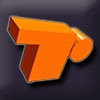 |
|
Reviews, updates and in depth guides to your favourite mobile games - AppGamer.com
|
|
Patterns and tiling question |
|
| Page: 1 | Reply |
| Feb 18th 2007 | #176332 Report |
 Posts: 12 |
I am home schooling a grandchild who is taking an online Adobe photoshop course designed for PS7.0 Unfortunately, I only PS 6.0. That has made it necessary to be fairly creative to do some of the exercises. Pattern Maker (under Filter) apparantly was added to 7.0. The current lesson calls for setting some perameters then creating your own pattern and tiling the pattern to make a whole new background. Are there any plug-ins that can be added to 6.0 that will do this or are we stuck with some sort of cut and paste exercise to get around this lesson? Are does anyone know a way to make a tile in 6.0?
|
| Reply with Quote Reply | |
| Feb 18th 2007 | #176333 Report |
 Posts: 2237 |
Creating seamless tiles can be tricky but if I remember PS6 correctly you can: Choose or create an image that the dimensions are divisible by 2. For example 400px x 300px = 1200 1 Duplicate the background image so you have two identical images one on top of the other. 2 With the top layer highlighted go Filter>Other>Offset. Enter values that are half the dimensions of the image. Check"wraparound". You will see your image broken in four sections with obvious seams. 3 Layer>Add Layer Mask>Reveal All. (or you can click on the little mask icon at the bottom of the layers Palette).The mask will be white. 4 Get a nice fat airbrush say 50px for an image this size.Select black color. Make sure you are in the mask edit mode for this layer. Go over the seams with the black airbrush. You will see a black cross on the white mask icon in the layers palette. The seams will disappear. 5 Flatten your image. Now if you used this image to do a pattern fill you would still see seams. You have to repeat the process a few times. get the pattern you like flatten the image do a "select all" and go Edit > Define Pattern. Now you can fill whatever (selection, layer, whatever) with that image. |
| Reply with Quote Reply | |
| Feb 19th 2007 | #176335 Report |
 Posts: 12 |
Thanks for the reply. Am trying to follow step by step but when I get to the point where you say get the airbrush and go into mask edit mode, (#4), I do not se a black cross on the white mask icon in the layers palette.
|
| Reply with Quote Reply | |
| Feb 19th 2007 | #176336 Report |
 Posts: 2237 |
You don't see the cross, but are the seams disapearing? 3 things come to mind..... Insure that you are painting on the "mask" by clicking on the mask thumbnail on that layer. Insure that you are painting with black and not white. (make black the forground color) You may have to up the opacity of your brush. |
| Reply with Quote Reply | |
| Feb 19th 2007 | #176339 Report |
 Posts: 12 |
Let's see. More basic question for starters: I need to copy and past the pattern image (head of a spoon) to begin the whole process and put it on a background (150 x 100 pixels). Once that is done, do I need to do anything else before I proceed to duplicate the image? I have done some photo editing but not every just played with the graphics capabilities of this program so doing this assignment is sort of the blind leading the blind situation. I have duplicated the image, offset as per the instructions (just offset in the vertical direction so there are only halves rather than fourths) and can make the new layer mask. When you say "seams". do you mean the checkerboard empty space???? I really appreciate your help! |
| Reply with Quote Reply | |
| Feb 19th 2007 | #176340 Report |
 Posts: 12 |
Unfortunately there is no graphic in the text showing what the finished page should look like, but I have seen tiled patterns and assume it will be the spoonheads flush against each other all over the page. There are no further instructions to distort them in any way. I HAVE managed to save the offset image as a pattern and can fill a page with it ... but that produces several lines of spoon heads down the "page" ... not spoonheads flush against each other. I think I can make that happen if I use a different sized original pattern than specified in the directions ... so I do not know if I am trying to make something harder out of a simple process or if I just don't "get it".
|
| Reply with Quote Reply | |
| Page: 1 | Back to top |
| Please login or register above to post in this forum |
| © Web Media Network Limited. All rights reserved. No part of this website may be reproduced without written permission. Photoshop is a registered trademark of Adobe Inc.. TeamPhotoshop.com is not associated in any way with Adobe, nor is an offical Photoshop website. |